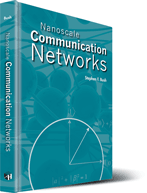
IEEE Communications Magazine review:
Nanotechnology has been a very promising research topics in recent years, leading to successful practical implementations. The achievements in this area have led to a growing interest in nanoscale networks. Nanoscale Communication Networks is a kind of primer which prepares the reader for the convergence of Nanotechnology and networking, giving also the necessary information for further reading or self-research. Let us take a rough route through this book. The author, being well aware of the fact that the downscale world is a highly interdisciplinary matter, assumes that the reader has basic knowledge of chemistry and biology, a bit deeper understanding of computer science, and mastered mathematics, physics, and telecommunications at the university level. Thus, in Chapter 1 the infrastructures are being placed in human surroundings, namely sensor networks, in addition to that, some review regarding previously mentioned sciences is done. The next two chapters deal with biological mechanisms needed for downscale communications, among others organic structures utilized for data transmission, simple computation and cell signaling. In Chapter 4 the reader is accustomed with non-organic nanostructures for network communications, namely carbon nanotubes. Additionally, their electrical and mechanical properties are presented along with their capabilities for transmitting information and computation. Quantum networking is a topic to which Chapter 5 is entirely devoted. No prior knowledge regarding quantum mechanics is expected, so one can find a really good introduction covering quantum states, measurement, entanglement together with other aspects of quantum networking, including such issues as security, teleportation and channel swapping. Information theory with regard to nanonetworks is presented in Chapter 6. That involves traditional concepts followed by both quantum systems and molecular communications. Having presented all the relevant nanoscale mechanisms, thus laying down the firm background of the readers' understanding, the author moves to the topic of architectural challenges in Chapter 7. This field is claimed still to be an unsolved problem so the author gives examples of currently used technologies and points out at potential architecture solutions such as self-assembling, carbon nanotubes or quantum systems. That is why it makes the book even more valuable for those who intend to involve nanonetworks in their research. Despite the fact that nanonetworks raise new problem types and require a new approach to them, some aspects of networking are well known in present networks. This chapter also deals with employing solutions found in outer-space networks into inner-space implementations. The core of this book is finalized with a chapter concluding all previous considerations, with the idea behind them of creating a fully functional nanoscale Internet. Somehow apart from the topic itself, the reader can also find an appendix which gives rather descriptive than teaching examples of nanoscale and molecular simulations tools, that are very desirable when dealing with terra incognita whatever would that be.
Summing up, Nanoscale Communication Networks is a demanding but also very interesting book, some kind of an ambitious primer. That way, it is definitely a good starting point for further reading. The author guides through all the aspects of nanonetworks, giving in most cases a clear description of his thinking process and altogether with transitions between equations. There are also many cross references between chapters and sections which give a broader view of the topic and help to memorize it. One can also find many pictures, diagrams and tables throughout this book in order to systematize the presented knowledge. Another advantage is the existence of an exercise section at the end of each chapter which enables to verify understanding and, when needed, to go back to the right section and re-read desired fragments. There are also a few aspects that could be regarded as drawbacks of this book, such as sporadic inadequate assumption regarding the readers' knowledge or over detailed description of trivial issues. However, these might be very subjective and do not influence the overall perception of Nanoscale Communication Networks as a very good and valuable book.
-IEEE Communications Magazine
August 2011
